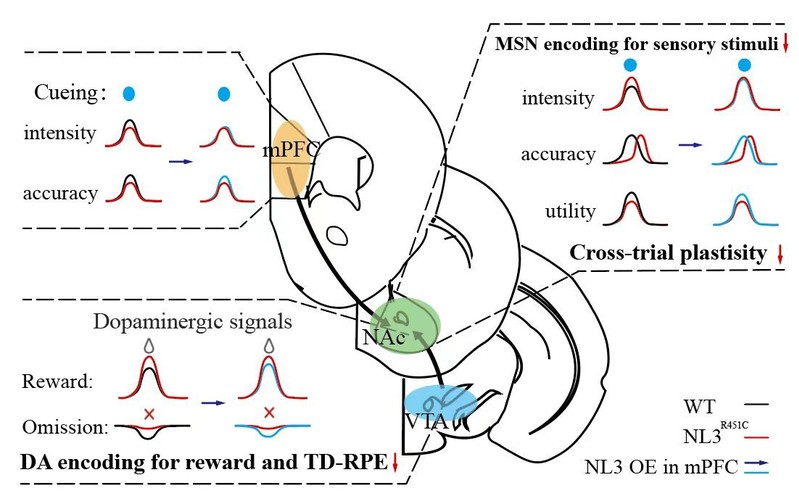Jianhong Luo's Group Published in Molecular Psychiatry on cognitive inflexibility in ASD mice model
Jianhong Luo lab from the School of Brain Science and Brain Medicine at Zhejiang University published a paper in Molecular Psychiatry, revealing the mechanisms of frontal-striatal circuit dysfunction that lead to cognitive inflexibility in the autism mouse model NL3R451C. Cognitive flexibility is an important component of executive function, enabling animals to respond appropriately to constantly changing environment. Autism Spectrum Disorder (ASD) is characterized by social deficit, repetitive, stereotyped behaviors and limited interests, the underlying mechanisms of which may involve deficits in cognitive/behavioral flexibility.
Neuroligin-3 (NL3) is significant in synapse formation and function, and its R451C missense mutation is associated with ASD. The knock-in mouse model NL3R451C exhibits autistic-like characteristics. Using two alternative forced choice task, the authors found that NL3R451C mice exhibited behavioral inflexibility in dynamic learning tasks.
To investigate the neural mechanism of decision-making flexibility in reward-based learning tasks, the authors conducted single-neuron firing rate analyses and discovered that medium spiny neurons (pMSN) in the nucleus accumbens (NAc) of knock-in (KI) mice showed enhanced response to cue stimuli, and the modulation of their firing rate changes by previous task outcomes was reduced, indicating impaired experience-dependent neural plasticity. Role of midbrain-limbic dopamine (DA) signaling in the cognitive rigidity of KI mice was then studied, it was observed that DA dynamics and reward prediction error (RPE) signals, which are used for motivation and guiding goal-directed learning, were significantly disrupted in KI mice, hindering the acquisition of new strategies in set-shifting tasks. Subsequently, authors found that the medial prefrontal cortex (mPFC)-NAc circuit in KI mice was impaired using fiber photometry recording. Re-expression of NL3 in the mPFC could effectively rescue the cognitive inflexibility phenotype of KI mice, while simultaneously reconstructing the output of the mPFC-NAc, NAc MSN encoding, and DA signal dynamics, establishing the crucial role of mPFC in the cognitive flexibility deficits of NL3R451C mice.
In summary, this study reveals the association between frontal-striatal circuit functional and DA modulation dysfunction and cognitive inflexibility in ASD mice, providing new insights into the neural mechanisms of cognitive/behavioral flexibility deficits and offering potential new strategies for intervention.








